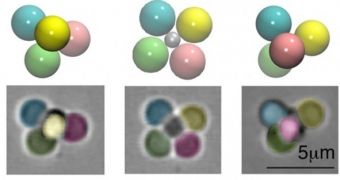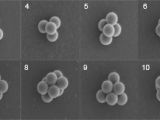Water, and most other liquids, usually spell doom for electronics of all kinds, but researchers from the University of Michigan and New York University have looked past that in their quest to invent a new way of storing data.
The result of their activities was the “wet computing” technique, which mimics biological processes, or other things found in nature like the DNA living in cells.
The basic idea is that plastic nanoparticles can form a one-bit cluster – the main building block of information storage – when they are deposited in a liquid.
From there, the scientists began to set up the particles in different configurations, which correspond to different states. Take for example a cluster of four particles connected to a central sphere. It can have two states, like a conventional bit.
Raise the number to 12 particles though, and you get 8 million unique states, the equivalent of 2.85 bytes of data, 22.9 conventional bits in other words.
Scale it upwards and you reach the point where a whole terabyte of data can be stored in a tablespoon of that solution. That's as much data as a smartphone, and more than most SSDs (barring PCI Express ones) can hold inside them.
Needless to say, the possibilities of these so-called liquid hard disk drives are staggering, especially since the liquid was made from cheap materials. That's one of the major deterrents of many research projects: reliance on rare elements, some of which are the cause of ongoing wars in countries from Africa, among other places.
For those who want more technical details, the team behind the liquid HDD, led by Sharon Glotzer and David Pine, used a colloidal suspension, meaning that particles are not permanently dissolved in the solution, allowing them to retain their expected properties.
This is in line with general “soft matter” attributes. You see, soft matter has predictable physical behavior at various temperatures, which is key, as it means the matter changes shape on the molecular level. Thus, the particles reorient themselves in predictable ways when you heat the solution. It's why rearranging the particles mentioned before in different states was possible.
In a group of four nanoparticles, three shifted on the surface of the fourth, central sphere, adopting different configuration. And since these simple, 4-particle clusters have only two distinguishable configurations (other than the default, unstimulated state), it is possible to store binary data. Not bad for an assembly only 5 micrometers across.

 14 DAY TRIAL //
14 DAY TRIAL // 
